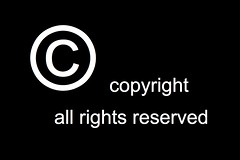DISCLAIMER: Recent conversations with the Copyright Office have led me to change my stance regarding blogs and copyright registration. Please see this post for my updated views.
I’m working on my first ebook, which is tentative titled The Legal Side of Blogging. During law school, I wrote a substantial research paper on copyright, defamation, and privacy issues related to blogging. I also wrote a blog series called Can My Blog Get Me Sued, Arrested, Fired, or Killed. It made sense to combine the material from these two projects and present them in a way that was useful to the average blogger for my first solo book project.

Blogs didn’t exist when the Copyright Act was written or last revised. The drafters only considered literary works that are published on paper when they wrote the law. When it comes to copyrighting blogs and websites, the best we can do is to try to find the digital equivalent to the works published on paper and register them accordingly.
The purpose of the Copyright Act is to protect advancements in the arts and sciences by giving authors and artists protection for the works they create. Copyright protection is afforded to every original expression that is fixed in a tangible medium. The law was written to protect things like books, photographs, music, sculptures, paintings, and audiovisual works. Works that exist only in an electronic form are fixed in a tangible medium, and thus, the law protects them.
I’ve spent hours considering the copyright implications of blogging and discussed it at length with my cyberspace law professor. We came to the conclusion that bloggers who blog on a set schedule are most like people who write a column in a newspaper or a magazine; and therefore their blogs should be able to be registered as serial works.
A single work can be registered with the United States Copyright Office for $35. If you publish a blog every week and register it, that will cost $1820 each year. The benefit of having a serial work is that you only have to register it every 3 months for $65, which is only $260 for the year. This saves a lot of time and money.
This week I was working on my ebook and I needed some clarification on how bloggers should go about registering their works, so I called the Copyright Office. The operator was very helpful in directing me to the circular on serial works, and she thought my ebook idea was interesting. Â About five minutes later, I had a follow up question so I called her back. She said she was glad I called back because she needed to tell me that blogs cannot be registered as serial works. The only thing a blogger can do is register each post individually!
Seriously?!?!?!
I can see the Copyright Office requiring individual registrations for each post for someone who only writes sporadically; but this rule makes no sense for someone who posts on a weekly basis. They should be given the same protection as any other writer who publishes in a similar fashion in a newsletter, journal, or magazine. Â Thankfully, the law protects writers’ and artists’ work the second a work is created, not from the date it is registered. The benefit of copyright registration is that you get to collect attorneys’ fees and statutory damages if someone steals your work and you successfully sue them.
I used to think that the best thing a blogger can do is register their blog as a serial work and use Google Alerts to monitor the internet for possible infringement. With this latest development, it makes more sense not to register every blog post you write, but only those that you expect someone will try to pass off as their work. You can still use Google Alerts to police the internet for potential infringers. You just won’t be eligible for attorneys’ fees or statutory damages if your work hasn’t been registered within 3 months of publication if you find that someone is passing off one of your blog posts as their own. However, you can probably still get the post removed from the infringer’s website using a takedown notice under the Digital Millennium Copyright Act.
Related articles
- Learn the Difference Between Registered and Non Registered Copyrights (rawbusinesslaw.com)
- Copyright: What is It? (rawbusinesslaw.com)
